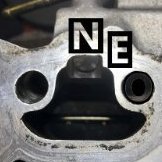
hq_
Members-
Posts
4 -
Joined
-
Last visited
-
Feedback
0%
Profile Fields
-
Car(s)
R32 GT-R, R33 V-Spec
-
Real Name
Henri
Recent Profile Visitors
672 profile views
hq_'s Achievements
-
Good points, but there's a major problem. While the rulebook follows FIA guidelines, there are some notable exceptions. Engine and drivetrain are very restricted. To sum it up: MY 1998 or older car model, original naturally aspirated engine, less than 132kW in stock form. Displacement affects minimum weight. OEM intake and exhaust manifolds and throttle body. OEM transmission, no LSD, final drive ratio from same model series. Cams, pistons and head porting are unrestricted, but there's just so much you can do when manifolds are the limiting factor. Pump fuel only, which effectively limits the compression around 11.5-12:1 at most. Fortunately this rules out most Hondas with 1.8l or larger displacement so competition is less than fierce, technologically speaking. Then there's the fuel capacity limit. 26l tank, 20l maximum per refueling. If you go all out for HP, you'll be refueling at least twice more than the competition during a 6 hour race and each stop costs you around 3.5 minutes. So, now that the background is sorted out, it may be obvious why I've contemplating RB20DE NEO. Dare to be different too, but after some 26 years of tinkering with RB26:s, trying to make power without stroking, resleeving and boosting the heck out of RB sounds like an interesting challenge. Not to mention the R34 bodyshell with functional GT-R/Z-Tune aero bits is one heck of a sponsor magnet compared to a mundane BMW sedan or Honda Civic. Still... anyone have an idea about the differences between RB20 and 25 head/manifolds/etc.?
-
I've seen RB2*DE NEO engines called VE on some occasions even though the NVCS doesn't quite justify the moniker. Nissan VE-engines like SR20VE alter valve lift along with timing, which AFAIK isn't available on RB heads. The difference in specific output is negligible but in absolute terms it's 42hp. Atmospheric RB25DE NEO does have small port volumes to maintain intake charge velocity and high BSFC efficiency, but the real question is whether they (and manifolds) are identical or even close to those of RB20DE NEO. I can't alter the stroke, the crank will obviously have to be knife-edged and balanced, but the block can be bored out to a degree. Not quite to the venerable RB24 specs, though, so the difference has to be made up with hot cams and revs. At that point, a lot more air will have to be moved to make power, not unlike when increasing displacement. The ability of the head and manifolds to move a sufficient amount of air to make at least 170 crank kW is the key. That's been done with unmodified RB25 NEO manifolds and head so if they're the same (or close enough) in RB20, we're in business. The point is that we'd love to race an HR34 coupe in a class dominated by E36 BMW:s and VTEC Civics and in order to do that we'll have to use OEM 2.0l, naturally aspirated engine. This is endurance racing so the NEO head being a semi-lean-burn design is also an advantage. We can map it for optimum BSFC but it also has to be able to make power at top end to be competitive. I raced an E36 in the same series earlier for several years. It made 174kW and was very competitive in terms of speed, but fuel consumption held it back in longer, 6-24 hour races.
-
I'm researching possibilities for yet another project and this involves building a modified RB20DE NEO. Probably with a larger bore for slightly more displacement in oversquare configuration. Not quite 2.5l, though, but as the power will be have to be made with revs, the breathing ability of the setup is crucial. The jump from 155 to 197 crank hp between RB20 NEO and RB25 NEO is significant so I've been trying to research what, exactly, Nissan has done to accomplish this in addition to larger displacement. There's really no point in reinventing the wheel when engineers at Nissan have already done most of the work for you. Has anyone compared the heads, intake manifolds, throttle body and exhaust manifolds side-by-side? Port sizes and volumes, valve sizes etc. are of interest in this case but simple observations are useful as well. Using aftermarket parts is out of the question because of racing class rules so I'll have to make do with stock and modified Nissan parts. All help is much appreciated.
-
As RB30:s aren't common at wreckers here in Finland, I'm looking for a bare crank, straight and undamaged, and with as little wear as possible. I'm looking to spend approximately $100, or $150 at most for an exceptionally good one, plus overseas shipping costs of course. Contact me by pm or, preferably by email at hq (at) gt-r.com. Thanks!


